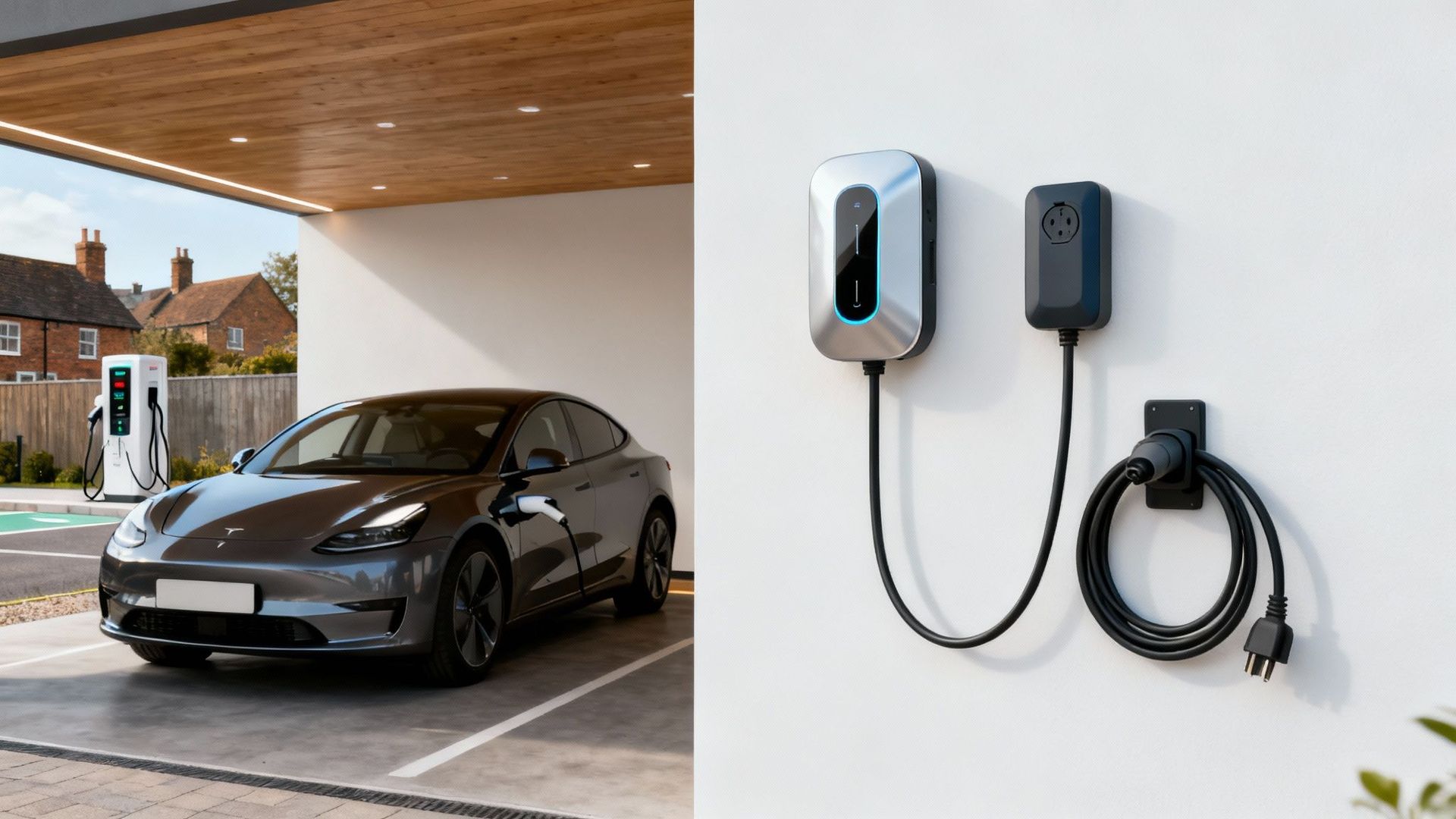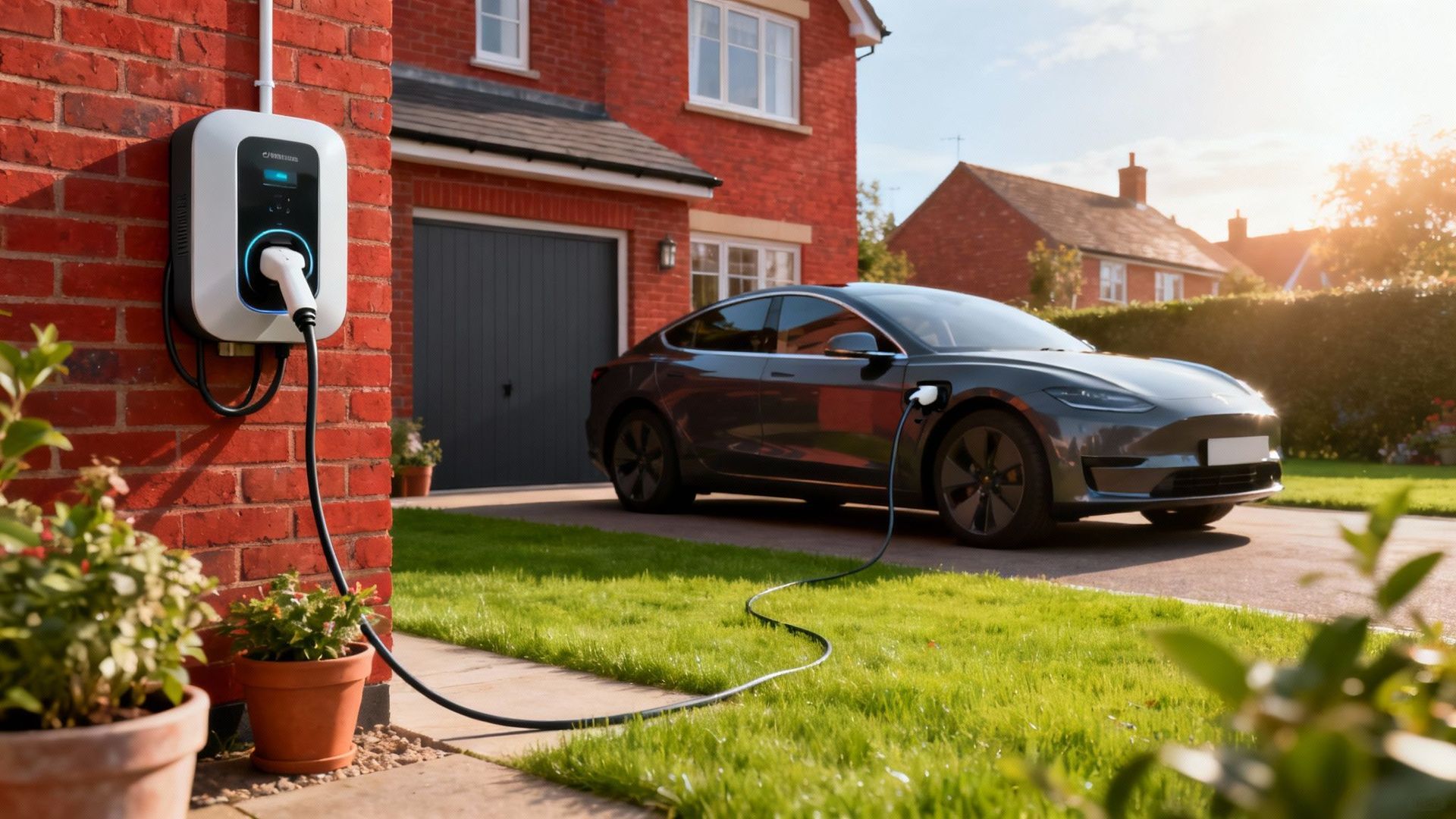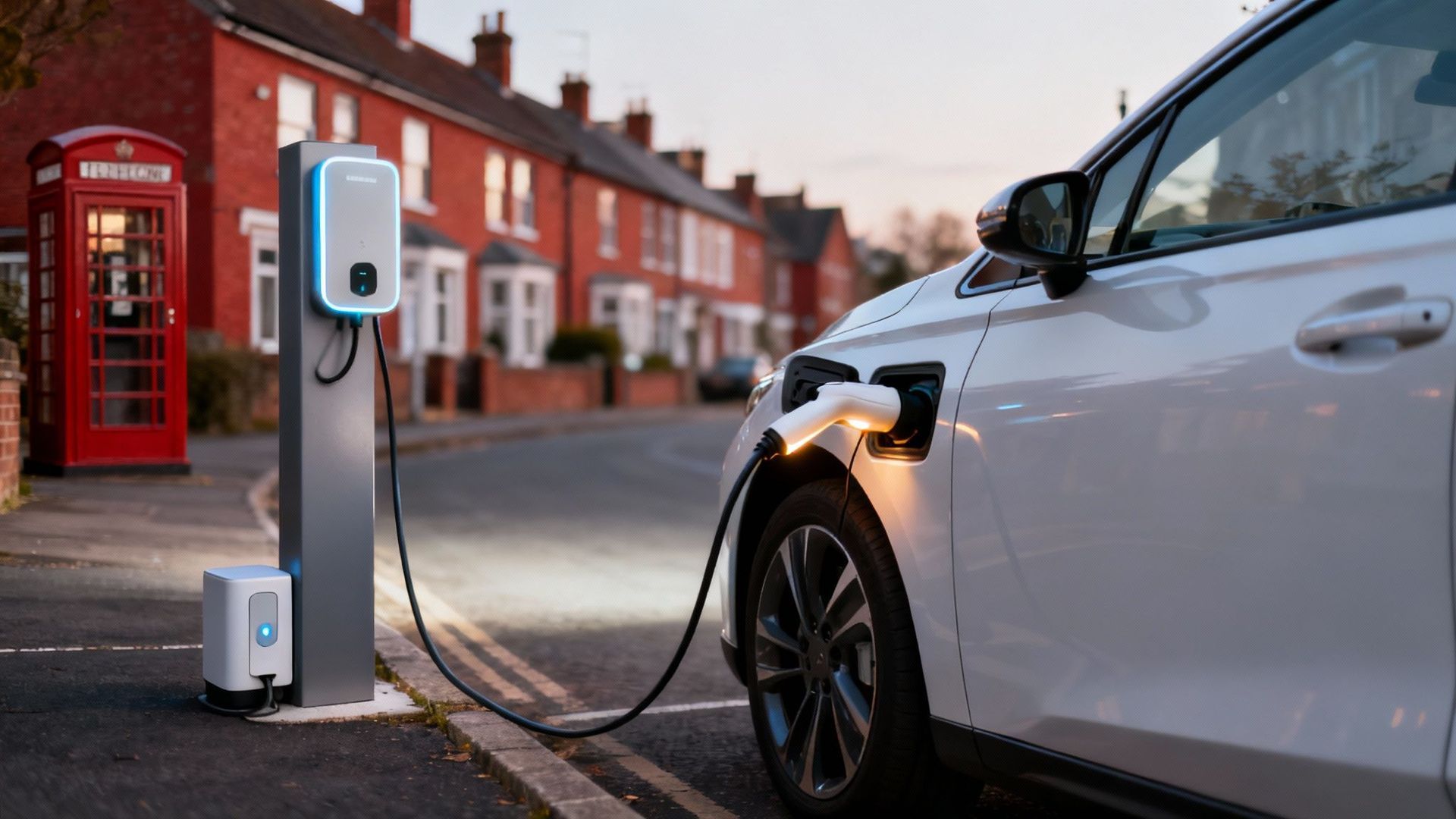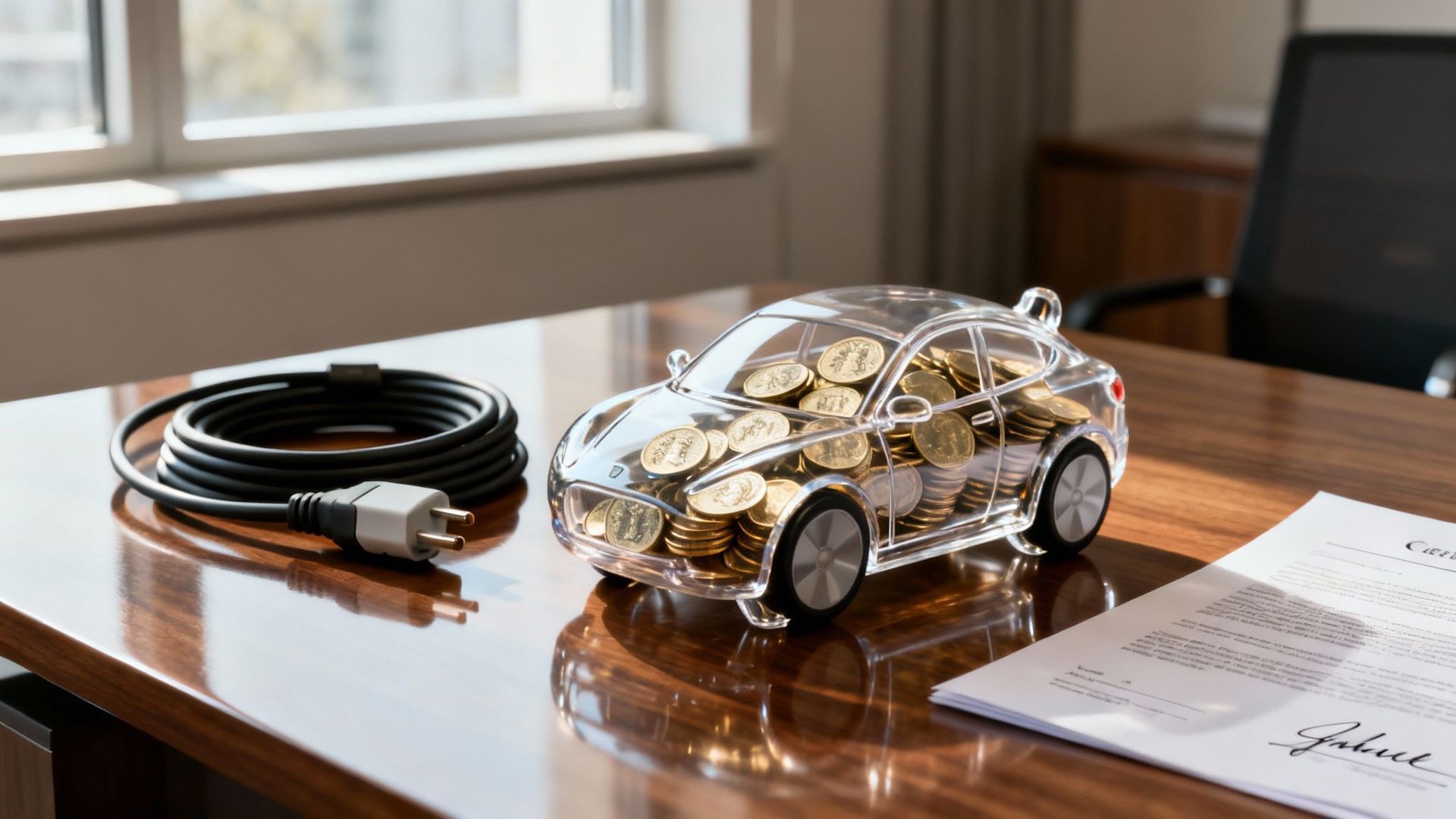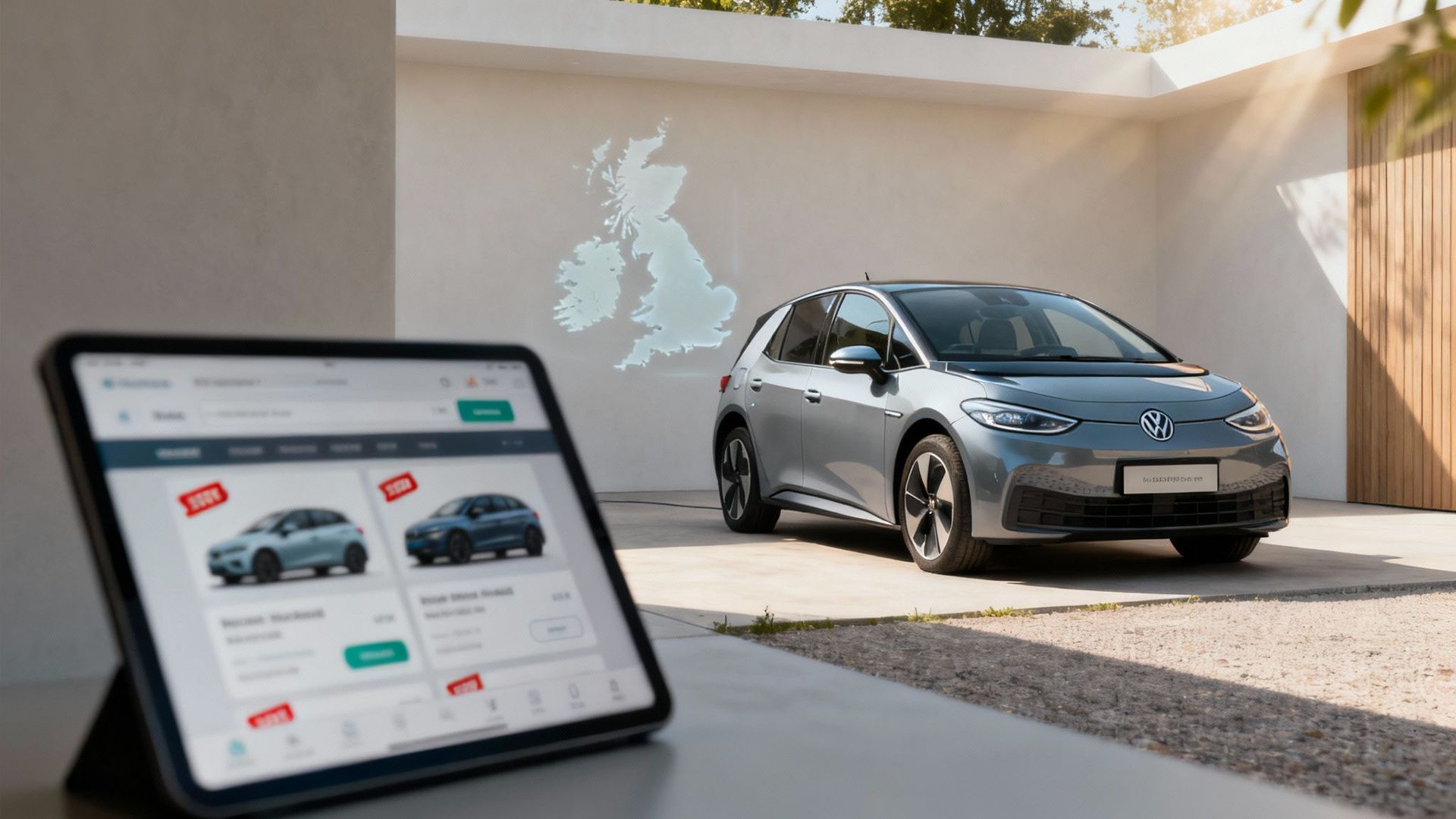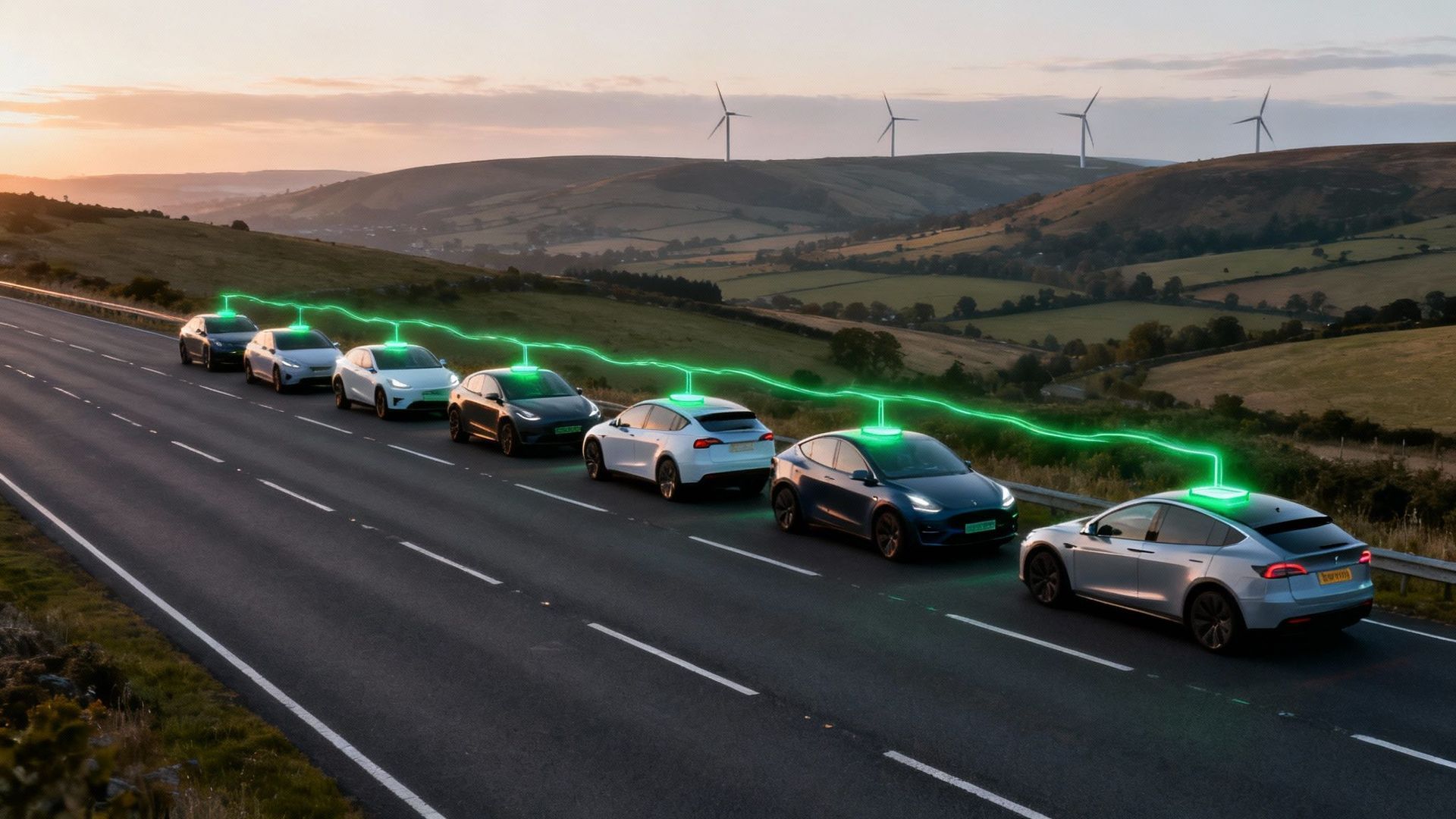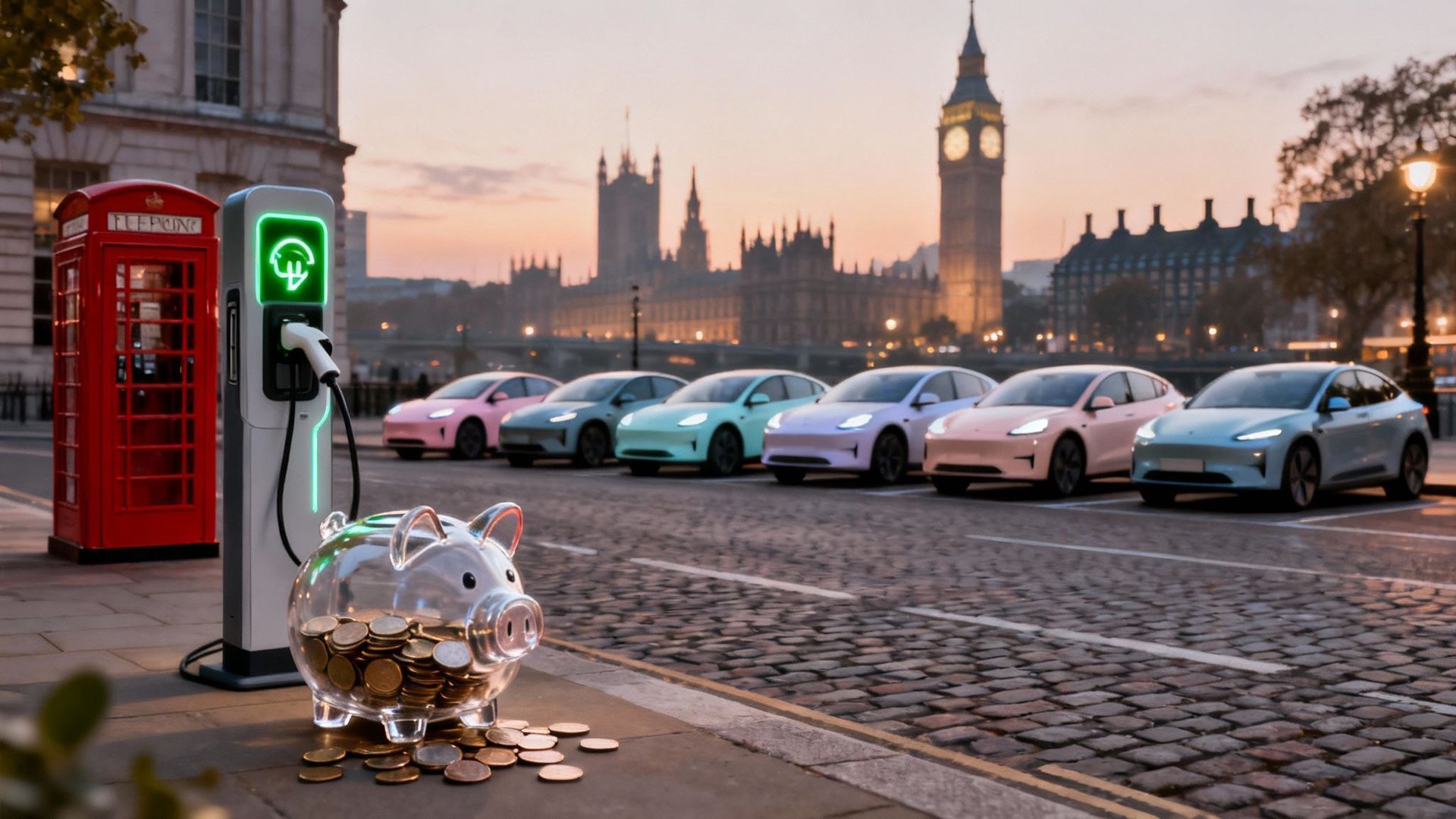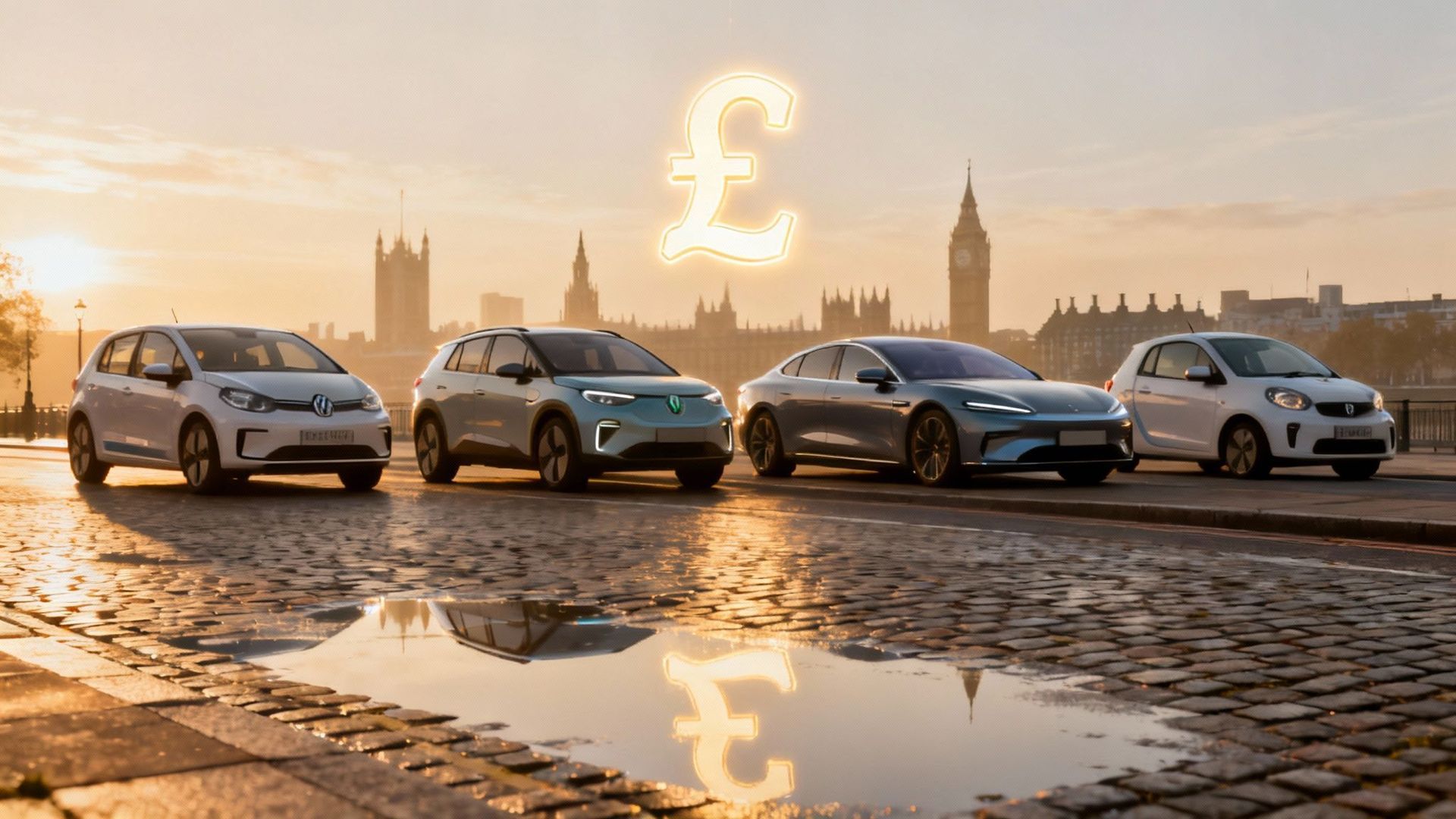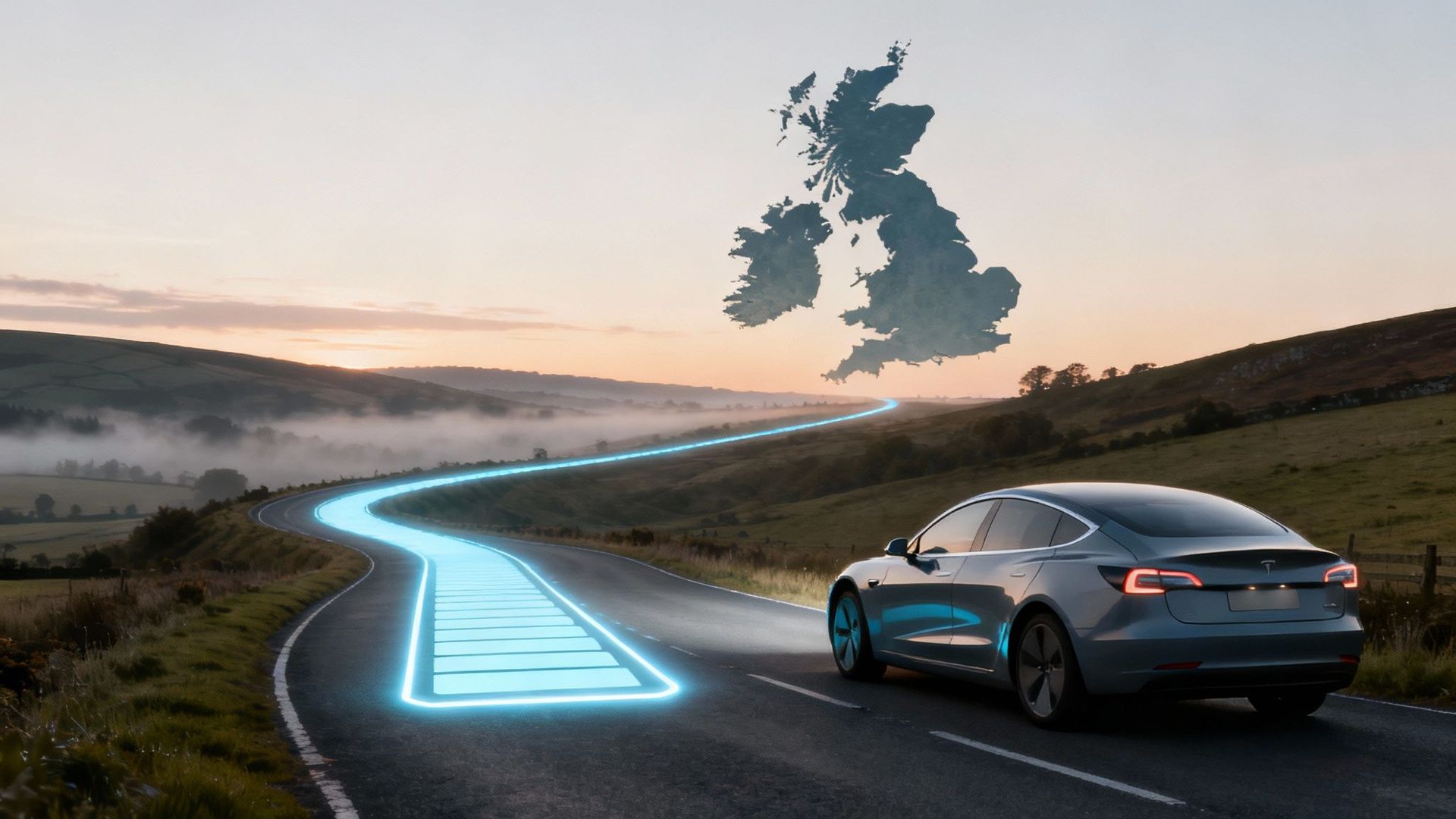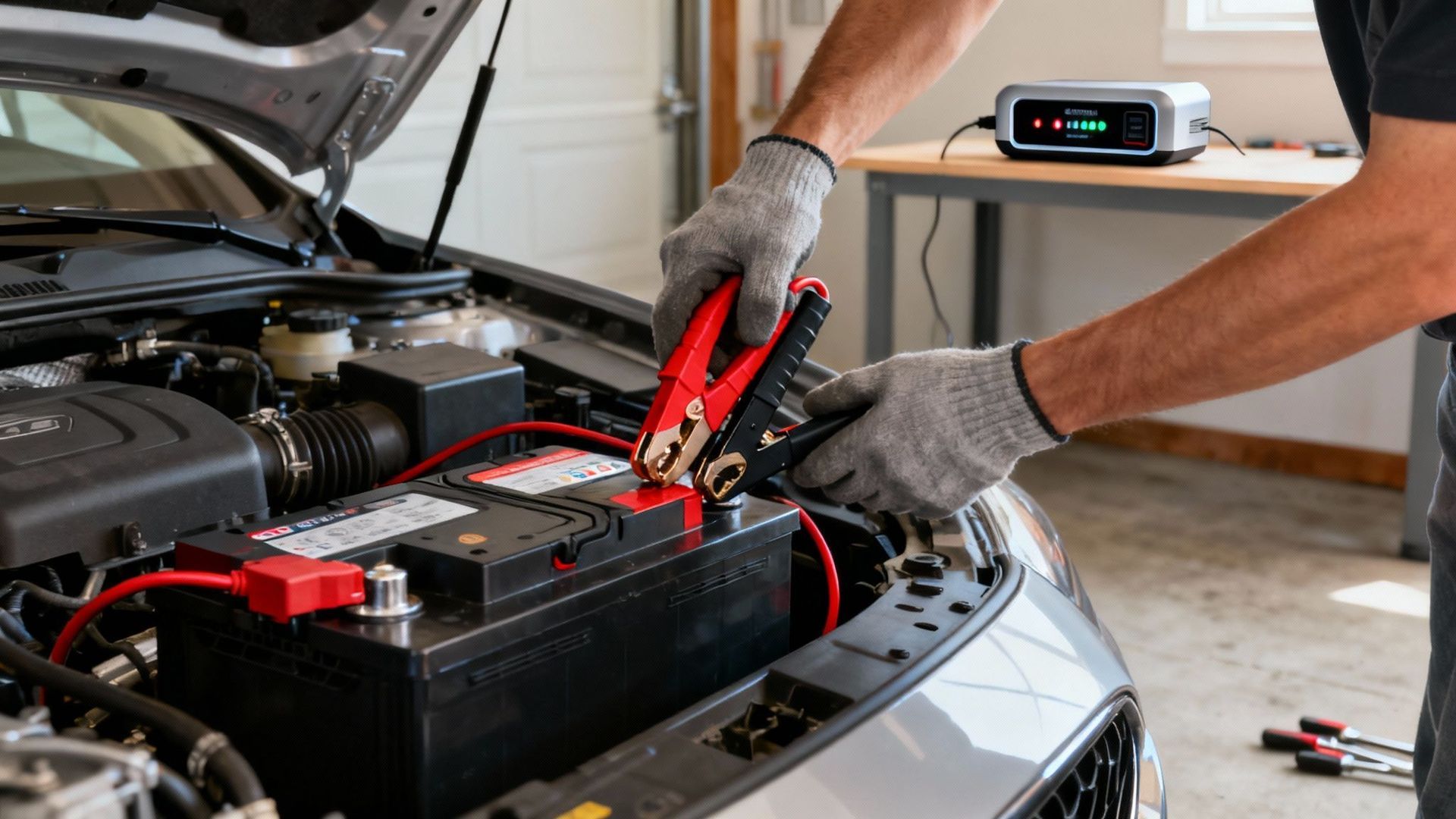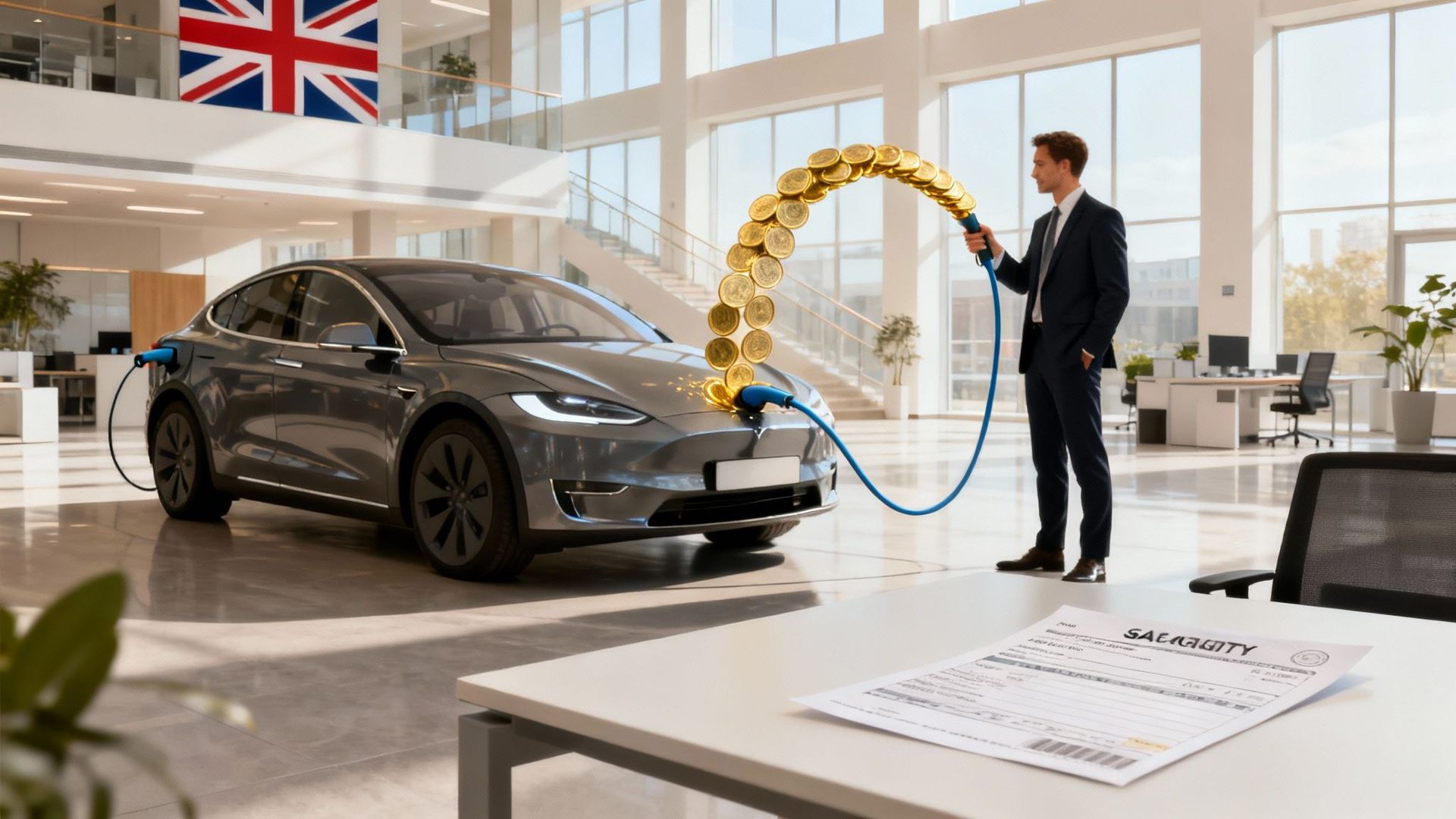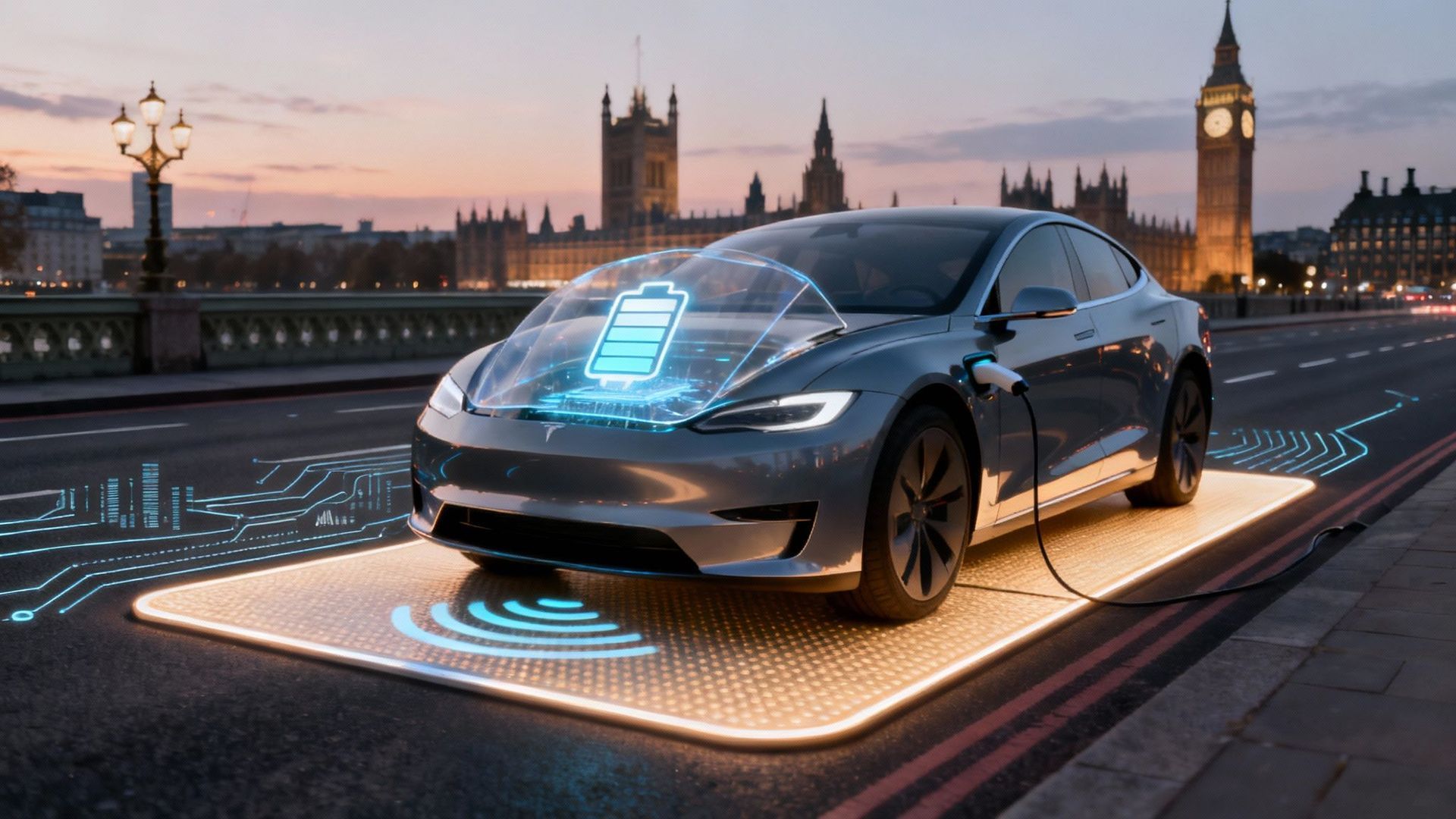Electric Vehicle Salary Sacrifice Schemes: A Sceptic's Guide to Bagging a Bargain
Right, let’s get straight to it. You’ve probably heard the term "EV salary sacrifice" floating around the office, likely from that smug colleague who just turned up in a brand-new electric car that seems way above their pay grade. It sounds a bit formal and confusing, like something out of a tax inspector's fever dream, but the idea behind it is actually dead simple—and devilishly clever.
What on Earth Is an EV Salary Sacrifice Scheme Anyway?
At its heart, an EV salary sacrifice scheme is a brilliant employee benefit, actively encouraged by the government, that lets you lease a brand-new electric car through your job. You simply agree to give up a chunk of your pre-tax salary each month, and that money pays for the car. Because the payment comes out before the taxman gets his grubby mitts on it, you end up saving a tidy sum on Income Tax and National Insurance. It’s one of the most cost-effective ways for UK employees to get behind the wheel of an EV without selling a kidney.
Let's break it down with a simple analogy. Imagine you're about to buy a £100 pair of trainers. Normally, you’d use the money that’s already landed in your bank account—the cash that HMRC has already had a good nibble at. But what if you could pay for those trainers using your salary before the taxman got his share? Your taxable income would be £100 lower, and you'd pay less tax as a result.
That’s precisely how a salary sacrifice scheme works. The car payment is deducted from your gross salary (the bigger, more optimistic number on your payslip), not your net pay.
By paying for the car before tax, you shrink your taxable income. A smaller taxable income means you pay less Income Tax and less National Insurance. It’s a genuine perk, and one the government is happy for you to take advantage of to encourage the switch to electric.
The Basic Deal
So, what does this arrangement actually look like? It’s basically a three-way agreement between you, your employer, and a leasing provider.
- You agree to exchange part of your gross salary for a non-cash benefit—in this case, a shiny new EV. It’s not a pay cut; it's a far cannier way of getting paid.
- Your employer leases the car on your behalf and deducts the monthly cost directly from your pre-tax salary.
- The result? You drive away in a brand-new electric car, often with insurance, maintenance, and breakdown cover all bundled in, for much less than a personal lease would cost.
This setup is a genuine win-win. You save a packet on tax, which suddenly makes driving a top-of-the-range EV surprisingly affordable. Your employer also saves money, as their National Insurance contributions are calculated on your new, lower salary. It makes them look like a fantastic, forward-thinking company for offering such a great perk, and it costs them next to nothing. Pretty smart, isn't it?
How the Tax Savings Actually Work
Right, let's get into the juicy bit. How does an electric vehicle salary sacrifice scheme actually save you a packet? The whole glorious system hinges on one wonderfully boring bit of tax law called Benefit-in-Kind (BiK) .
For years, company cars—especially the old petrol and diesel dinosaurs—have been hammered by BiK tax. Think of BiK as the taxman’s way of saying, "Nice perk you've got there, mate. I'll be having a slice of that." It's calculated as a percentage of the car's value, and for traditional engines, that percentage is painfully high, often wiping out any real savings.
But for pure electric vehicles, the government has set the BiK rate at a ridiculously low level. It’s practically a rounding error, a deliberate nudge to get us all plugging in rather than filling up. This tiny BiK rate is the master key that unlocks a treasure chest of savings.
This infographic shows how paying for the car from your gross salary leaves more in your wallet at the end of the month.

Essentially, the tax savings come from shrinking your taxable income before HMRC gets its hands on it.
The Numbers Don't Lie
So, how does this actually look on your payslip? Let’s imagine a typical scenario. You fancy an EV that costs £500 per month on a lease. Instead of paying that from your take-home pay, you "sacrifice" £500 from your gross salary.
Because your gross salary is now £500 lower, both your Income Tax and National Insurance contributions drop. For a basic-rate taxpayer, you save 20% Income Tax and 8% National Insurance on that £500 chunk. Suddenly, the actual cost to you isn't £500 anymore; it’s significantly less.
The magic is simple: you’re using untaxed money to pay for the car. You get a brand-new EV, and the taxman gets less of your hard-earned cash. It's one of the few times you can genuinely, legally, and ethically beat the system.
A Tale of Two Taxpayers
The savings get even better the more tax you pay. Let’s crunch some real-world numbers to see the difference.
- For the Basic-Rate Taxpayer (20%): That £500 monthly sacrifice doesn't actually cost you £500. After saving on tax and National Insurance, the real-world hit to your bank account is closer to £360 . You're getting a £500 car for a £140 discount, courtesy of HMRC.
- For the Higher-Rate Taxpayer (40%): This is where it gets really interesting. Your savings are supercharged. That same £500 sacrifice could cost you as little as £290 from your net pay. That’s a whopping £210 saving every single month.
These dramatic savings are possible simply because the BiK tax rates for EVs are so low. For the 2025/26 financial year, the rate is just 3% , though it's set to creep up slowly over the coming years. This makes EV salary sacrifice one of the most tax-efficient ways to drive a new car right now. If you want to dive deeper into the nuts and bolts, you can learn more about UK electric car tax benefits in our simple guide.
The Best Electric Cars You Can Actually Get
If you think EV salary sacrifice is just a fancy perk for executives who want a Porsche Taycan, think again. While you can get those, the scheme has well and truly gone mainstream. The sheer variety of electric cars available now means there’s something for pretty much everyone, from zippy city cars to practical, family-sized SUVs.
This isn’t about some far-off dream. It's about getting behind the wheel of a brand-new, desirable car for a lot less than you'd imagine. The market is packed with fantastic options for every budget and lifestyle, turning this from a niche benefit into a genuine game-changer for thousands of employees.

From Budget Heroes to Premium Cruisers
The growth in choice has been staggering. You've got budget champions like the MG4, a car that really punches above its weight with sharp looks and a solid range, all without breaking the bank. Then there are the ever-popular family workhorses like the Kia Niro EV or the Skoda Enyaq, which are perfect for the school run, weekend getaways, and hauling all the stuff that comes with family life.
The savings are now significant right across the board. For instance, a 40% taxpayer could save around £181 per month on an MG ZS EV, while someone opting for a premium model like the BMW i4 could see savings closer to £350 per month .
This kind of saving makes incredibly popular cars surprisingly affordable.
- MG4 Trophy EV: Net monthly cost around £290 .
- MG ZS EV: Net monthly cost around £300 .
- Tesla Model 3: Comes in at just £567 after tax savings.
It's simple maths, really. Because you're paying from your gross salary, a car that seems expensive on paper suddenly becomes genuinely affordable. That sleek saloon or spacious SUV you’ve been eyeing up is now well within reach.
How Popular Models Stack Up
To give you a clearer picture, let's look at a few popular models you can get through an EV salary sacrifice scheme. The table below breaks down what a higher-rate ( 40% ) taxpayer might expect to pay. Pay close attention to the "Net Monthly Cost"—that's the figure that actually comes out of your take-home pay.
Salary Sacrifice UK Car Comparison
| Car Model | Gross Monthly Cost | Estimated Monthly Saving | Estimated Net Monthly Cost |
|---|---|---|---|
| MG4 SE EV | £495 | £205 | £290 |
| Tesla Model Y RWD | £698 | £290 | £408 |
| Polestar 2 | £780 | £324 | £456 |
| Audi Q4 e-tron | £995 | £407 | £588 |
Note: These costs are just examples and can vary based on your lease terms, company provider, and individual tax situation.
The numbers don't lie. Getting a premium SUV like the Audi Q4 e-tron for under £600 a month from your net pay is a seriously compelling deal.
If you’re finding it tough to choose the right EV, our guide on the 7 best electric cars in the UK for 2025 to avoid buying a dud can help you narrow it down. This is exactly how salary sacrifice makes a desirable car an attainable one.
How to Get Your Company on Board
So, you’re sold on the idea of driving a brand-new electric car for a fraction of the usual cost. Fantastic. But there's a small hurdle: your company has probably never heard of an electric vehicle salary sacrifice scheme .
Right now, your boss might think it’s some complicated tax scheme or just another admin nightmare waiting to happen. It's your job to show them the light. Your mission is to convince the people holding the purse strings that this isn't just a great perk for you, but a genuinely smart move for the entire business.
The best way to get their attention? Talk about the money they’ll save. For every single employee who joins the scheme, the company pays less in Employer National Insurance contributions . This is a direct, measurable saving that will make the finance department lean in and listen.
Crafting the Perfect Pitch
Don’t just pop your head into your manager's office and start rambling about tax breaks. You need to walk in with a proper business case. The most common objection you'll hear is the classic "it sounds like an admin headache." This is your moment to shine.
You can calmly explain that the company doesn't actually have to do any of the heavy lifting. Specialist providers handle everything from start to finish—finding the cars, sorting the insurance, and even managing the payroll adjustments. The admin for your employer is practically zero.
Think of it this way: you’re not asking the company to create more work for itself. You’re asking them to outsource a brilliant employee perk. The provider handles the admin, the company saves money on National Insurance, and you get a new car. It’s a win-win-win.
To really get this over the line, you need to present a simple, clear plan. Here's how to frame it so it doesn't sound like you're just trying to get a shiny new Tesla on the company's dime.
- Lead with their wins: Start with the employer NI savings . It's the strongest hook you've got.
- Destroy the admin myth: Stress that providers like The Electric Car Scheme or Octopus EV manage the whole thing. It’s designed to be unbelievably simple for businesses to set up.
- Play the green card: Offering an EV scheme is a huge tick in the box for the company’s environmental targets. It makes them look good, and it actually does good.
- Frame it as a talent magnet: In a competitive job market, a killer benefit like this helps attract and keep the best people. It shows they're a modern, forward-thinking employer.
Overcoming Potential Objections
Be prepared for the inevitable questions. "What happens if an employee leaves?" is a common one. The schemes have this covered with early termination protection. "What’s the actual cost to the business?" The answer is that it's designed to be cost-neutral, as the entire package is funded by the employee's gross salary sacrifice.
When you present it this way, your request transforms from a personal want into a strategic business proposal.
And if they're still a bit nervous about the practicalities of running EVs, you can point them towards a sceptic's guide to UK electric vehicle fleet management. It's a great way to show them it’s nowhere near as daunting as it sounds. Consider it your secret weapon for landing that perk you deserve.
Navigating the Fine Print and Potential Pitfalls
So, you’ve seen the impressive tax savings, picked out your dream EV, and are ready to get the ball rolling. But before you do, let's pump the brakes for a moment. As with any deal that seems almost too good to be true, it’s crucial to understand the small print. This isn’t about dampening your enthusiasm, but making sure you go in with a clear head, fully aware of any potential snags.
The most common worry people have is a big one: what happens if I leave my job? Whether you're made redundant, find a new role, or decide to pursue a lifelong dream of opening a Cornish pasty shop, a multi-year car lease tied to your employer can feel like a big commitment.

Luckily, the scheme providers have thought this through. They’ve built-in protection specifically for this scenario. Most modern schemes include some form of early termination protection as standard. This is designed to shield your employer—and ultimately, you—from eye-watering fees if your employment comes to an unexpected end.
Understanding Your Protection
This protection is your safety net, and without it, you could face a nasty financial shock. The specifics of the cover can vary quite a bit between providers, so it's absolutely vital to check the details of your company's chosen scheme.
Here’s what’s typically covered:
- Redundancy or Dismissal: In most cases, you’re protected from day one. If the worst happens, the car can usually be returned without you being hit with huge termination penalties.
- Resignation: This is also often included, but there might be an initial qualifying period before the protection kicks in—say, after the first three months of the lease.
- Long-Term Sickness or Family Leave: Life happens. These schemes generally cover significant changes in personal circumstances, giving you peace of mind that you won't face a financial penalty on top of everything else.
The key takeaway is this: the risk of being stuck with a car lease if you leave your job is significantly reduced by these safeguards. Gone are the days of being shackled to a company car, but you must read the provider's specific early termination policy before you sign on the dotted line.
The Knock-On Effect on Your Finances
It's also worth remembering that sacrificing a portion of your salary can have other ripple effects. Because your official gross salary is lower on paper, it can influence other financial calculations.
When you apply for a mortgage, for instance, lenders will look at your declared salary. While most are now familiar with salary sacrifice, you'll likely need to explain the arrangement and provide documents showing your pre-sacrifice income. The same goes for pension contributions, which are often based on a percentage of your salary. A lower gross pay could mean lower contributions, so it’s essential to clarify with HR if they can calculate your pension based on your original, higher salary.
When all’s said and done, an EV salary sacrifice scheme is a brilliantly cost-effective way to drive a brand-new electric car. Just make sure you do a bit of homework on the fine print, and you’ll be well-placed to avoid any surprises down the road.
Why This Brilliant Scheme Is Here to Stay
Whenever a tax break this good comes along, it’s easy to think it’s too good to be true. That little voice in your head starts whispering, "They'll close this loophole soon." Governments are known for changing the rules, after all, and a deal this sweet often feels like it's on borrowed time. It’s a reasonable worry, but when it comes to electric vehicle salary sacrifice schemes, you can relax.
This isn’t some accidental tax oversight that HMRC simply hasn’t caught up with yet. Quite the opposite, in fact. The scheme’s future is secure because it aligns perfectly with the UK’s legally binding net-zero targets. The government is all-in on getting more people into electric cars and away from petrol and diesel, and this scheme is one of its best levers for making that happen.
It helps to think of it as a strategic carrot, not an accidental loophole. By making EVs incredibly affordable for everyday employees, the government puts its foot on the accelerator for the transition away from fossil fuels. This is a calculated policy, designed to nudge the entire country towards cleaner transport.
A Government Priority, Not a Pension-Style Problem
You can really see how stable the scheme is when you compare it to other salary sacrifice arrangements that are genuinely at risk. While there’s plenty of talk about potential clampdowns on pension-related salary sacrifice, EV schemes have been left well alone. One survey even found that a huge 94% of C-suite executives are expecting restrictions on pension salary sacrifice any day now. Yet, even when HMRC looked at scenarios for removing tax exemptions on other benefits, EV schemes weren't touched. You can discover more insights about the security of these schemes and why they remain a government priority.
This level of policy stability is all the reassurance you need. It tells you this isn't just a fleeting perk but a core part of a long-term strategy.
The low Benefit-in-Kind (BiK) tax rates that make all these savings possible aren't a mistake; they are a deliberate, long-term incentive. The government has already published the BiK rates years into the future, giving both employers and employees the confidence to sign up for multi-year leases without worrying about a sudden policy U-turn.
This forward planning proves that electric vehicle salary sacrifice is a cornerstone of the UK’s environmental policy. For both you and your employer, that means setting up a scheme is a smart, secure, and future-proof move. It’s a brilliant deal, and it’s very much here to stay.
Answering Your Top Questions
Even with everything we've covered, a few questions always pop up. Let's tackle some of the most common ones that might still be on your mind.
How Does Salary Sacrifice Affect My Pension?
This is a really important one. Because a salary sacrifice scheme lowers your gross salary on paper, it could reduce your pension contributions if they're calculated as a percentage of that new, lower figure.
However, most switched-on employers prevent this from happening. They'll typically agree to continue making pension contributions based on your original, pre-sacrifice salary, so you don't miss out. The key is to confirm this with your HR department before you commit.
What’s Actually Included in the Monthly Payment?
Think of it as a comprehensive car subscription. One single monthly payment usually bundles everything you need to stay on the road, hassle-free.
Typically, this covers:
- The brand-new electric car itself
- Fully comprehensive insurance
- All routine servicing and maintenance
- Roadside assistance and breakdown cover
- Replacement tyres
Essentially, you just need to cover the cost of charging it. It takes nearly all the unpredictable running costs and turns them into one fixed, manageable payment.
What Happens if I Leave My Job?
Providers know that people change jobs—it’s a fact of life. The lease agreement is technically with your employer, not you directly. To handle this, most employers take out protection insurance that covers any early termination fees if an employee leaves.
In some cases, there might even be an option to transfer the lease to your new employer, assuming they're also part of a scheme. As always, the specific terms will be in the provider's policy, so it's wise to check that small print before signing up.
Ready to make the switch without breaking the bank? VoltsMonster brings you the best deals and no-nonsense reviews on the latest EVs. Find your next electric car on VoltsMonster.

